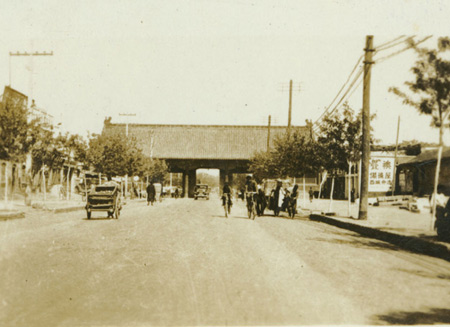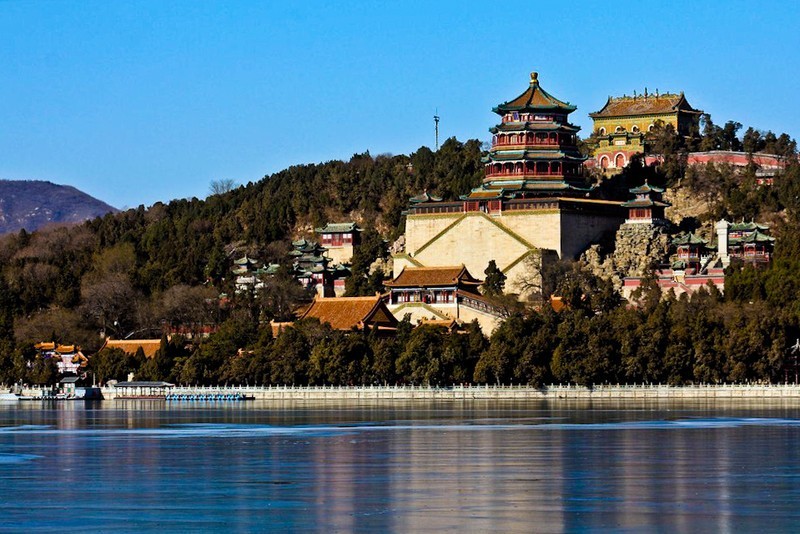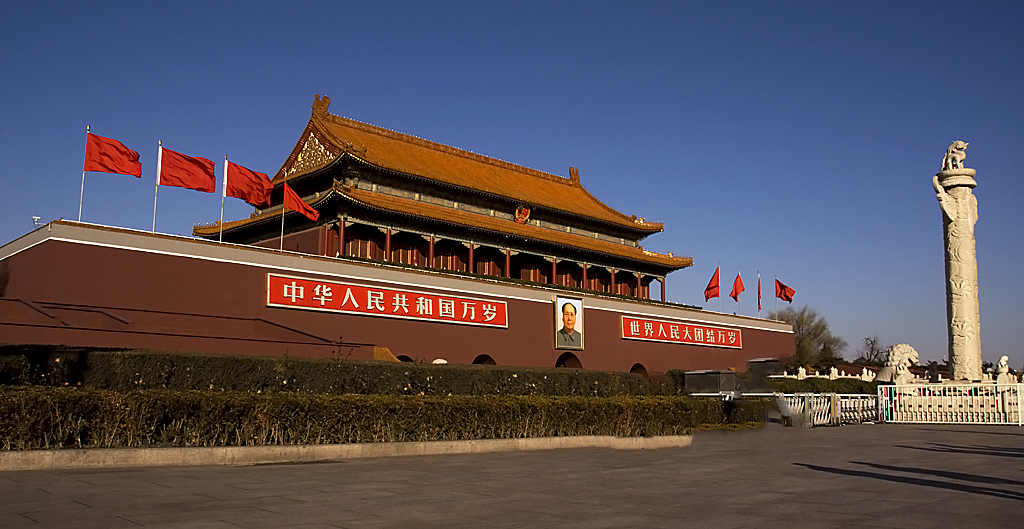24 Hours Hotline: +86 137-3541-1378
Email:beijing@tripstoshanghai.com
24 Hours Hotline: +86 137-3541-1378
Email:beijing@tripstoshanghai.com
Early history

The history of Beijing City can date back to thousands years ago. The earliest remains of hominid habitation in Beijing Municipality were found in the caves of Dragon Bone Hill near the village of Zhoukoudian, where the Homo erectus Peking Man lived from 770,000 to 230,000 years ago.Some half a million years ago, the climate of that time was warmer and more humid than now. Forests and lakes in the area supported large numbers of living creatures. The fossil remains of Peking man, his stone tools and evidence of use of fire, as well as later tools of 18,000 years ago, bone needles and article of adornment from the age of Upper Cave Man are the earliest cultural relics on record in China today. Homo erectus fossils from the caves date to 230,000 to 250,000 years ago. Paleolithic homo sapiens also lived there about 27,000 years ago. There were cities in the vicinities of Beijing by the 1st millennium BC, and the capital of the State of Yan, one of the powers of the Warring States Period (473-221 BC), Ji (?/?), was established in present-day Beijing. After the fall of the Yan, the subsequent Qin (221-207 BC), Han (206BC-220), and Jin (265-420) dynasties set up local prefectures in the area. In Tang Dynasty (618-907) it became headquarter for Fanyang Jiedushi, the virtual military governor of current northern Hebei area. An Lushan launched An Shi Rebellion from here in 755 AD.
Medieval period
The later of Jin Dynasty enlarged it's land in northern China in 936, including present Beijing area, to the Liao Dynasty. In 938, Beijing was choosen as the secondary capital of Liao Dyanasty, and called it Nanjing, which means the "Southern Capital". In 1125, the Jurchen Jin Dynasty conquered Liao, and in 1153 moved its capital to Liao's Nanjing, calling it Zhongdu (??), "the central capital." Zhongdu was situated in what is now the area centered around Tianningsi, slightly to the southwest of central Beijing. Some of the oldest existing relics in Beijing including the Niujie Mosque and the Tianning Temple date to the Liao era.
Mongol forces burned Zhongdu to the ground in 1215 and rebuilt it to the north of the Jin capital in 1267. In preparation for the conquest of all of China, Yuan (Mongol) Dynasty founder Kublai Khan made this his capital as Dadu (??, Chinese for "great capital"), otherwise spelled as Cambuluc in Marco Polo's accounts. In 1293 Construction of Dadu finished. The decision of the Khan greatly enhanced the status of a city that had been situated on the northern fringe of China proper. Dadu was situated north of modern central Beijing.There are remnants of Yuan-era wall still standing and are known as the Tucheng, literally means the "earth wall".
Ming and Qing Period

The city was rebuilt by the Ming Dynasty and Shuntian ( ??) prefecture was established in the area around the city after the Yuan Dynasty. In 1403, the third Ming Emperor Yongle moved the Ming capital south to Nanjing (Nanking) from the renamed Beiping (??), During the Ming Dynasty, Beijing took its current shape, and the Ming-era city wall served as the Beijing city wall until modern times, when it was pulled down and the 2nd Ring Road was built in its place. It is believed that Beijing was the largest city in the world from 1425 to 1650 and from 1710 to 1825. It is now the 17th largest city in the world.
The Forbidden City was home to the Emperors of the Ming and Qing dynasties (1368-1911).The Forbidden City was constructed soon after that (1406-1420), followed by the Temple of Heaven (1420), and a lot of other construction projects. Such as Tiananmen Square, which has become a state symbol of the People's Republic of China and is featured on its emblem, was burned down twice during the Ming Dynasty and the last time of reconstruction in 1651. Yongle moved the Ming capital back north to Beiping in 1421 as a measure to guard the empire against the Mongols and control the northern armies; He gave a new name to this place:Beijing (??), which means "northern capital".
Li Zicheng led a peasant uprising against the Ming regime about 40 days in 1644. Following the end of Li's control of the city, the Manchus captured Beijing. After the Manchus overthrew the Ming Dynasty and established the Qing Dynasty in its place, Beijing still was the capital city of China during the Qing Dynasty.
Republic of China
In 1911, the Qing dynasty was overthrown in the Xinhai Revolution. The Xinhai Revolution of 1911, aimed at replacing Qing rule with a republic, originally intended to establish its capital at Nanjing. After high-ranking Qing official Yuan Shikai forced the abdication of the Qing emperor in Beijing and ensured the success of the revolution, the revolutionaries in Nanjing accepted that Yuan should be the president of the new Republic of China, and that the capital should remain at Beijing. Yuan and successors from his Beiyang Army ruled the Republic from Beijing until 1928 when Chinese Nationalists reunified the country through the Northern Expedition and moved the capital to Nanjing. Beijing was renamed Beiping. In 1937, a clash between Chinese and Japanese troops at the Marco Polo Bridge outside Beiping triggered the outbreak of the Second Sino-Japanese War. Japanese occupiers created a collaborationist government in northern China and reverted the city's name to Beijing to serve as capital for the puppet regime. After Japan's surrender in 1945, the city returned to Chinese rule and was again renamed Beiping. During the subsequent civil war between the Chinese Nationalists and Communists, the city was peacefully transferred to Communist control in 1949 and renamed Beijing to become the capital of the People's Republic of China.
People's Republic of China

In the year of 1949, during the Chinese Civil War, Communist forces entered Beijing without a fight. On October 1 of the same year, Mao Zedong lead the Communist Party, announced in Tiananmen the creation of the People's Republic of China in Beijing. A few days earlier, the Chinese People's Polictical Consultative Conference had decided that Beijing would be the capital city of the new government, and that is its name would be changed back to Beijing.
The People's Republic of China was founded in Beijing in 1949, Beijing Municipality consisted of just its urban area and immediate suburbs. The urban area was divided into many small districts inside what is now the 2nd Ring Road. The Beijing city wall was torn down to make way for the construction of the 2nd Ring Road, which was finished by 1981 in accords with the 1982 city plan. That road was the first of a series of new ring roads intended for automobiles rather than for bicycles.
Since the economic reforms of Deng Xiaoping, the urban area of Beijing has expanded greatly. Formerly within the confines of the 2nd Ring Road and the 3rd Ring Road, the urban area of Beijing is now pushing at the limits of the recently-constructed 5th Ring Road and 6th Ring Road, with many areas that were formerly farmland now developed residential or commercial districts. A new commercial area like Wnagfujing, Xidan were developed in a busy and flourishing shopping area,while Zhongguancun has become a major centre of electronics in China.
Prev: Beijing Culture
Next: No next link
Wechat: Chinaprivatetour
24 Hours Hotline:
+86 137-3541-1378
* Authentic Experiences: Genuine local experiences that immerse you in the true essence of Beijing and beyond.
* Safety First: Highest safety standards with secure activities and reliable transportation.
* Customizable Tours: Flexible itineraries tailored to your interests and needs.
* Local Expertise: In-depth knowledge of Beijing and China, offering exclusive insights.
* Professional Guides: Licensed bilingual guides with over 5 years of experience.
* Comfortable Travel: Experienced drivers and well-maintained vehicles for a smooth journey.
* Sustainable Tourism: Commitment to responsible tourism and supporting local communities.
* Customer-Focused: Personalized service and continuous improvement based on your feedback.
* Free Cancellation: Cancel up to 24 hours before travel for flexibility and peace of mind.
* 24/7 Support: Round-the-clock assistance for any questions or help needed.
1 to 1 tailor-made service from our professional travel advisors for the most sophisticated
Constantly excellent reviews for attraction, hotel and service Competitive price
Local experts provide quality tours Best selected knowledgeable local guides Authentic local restaurants
7*24 hours available to create you a worry-free tour. No Hidden Fees and absolutely no pressure to buy. Secured









Copyright © 2017 Chinabeijingprivatetour.com All rights reserved. 浙ICP备18056007号-2